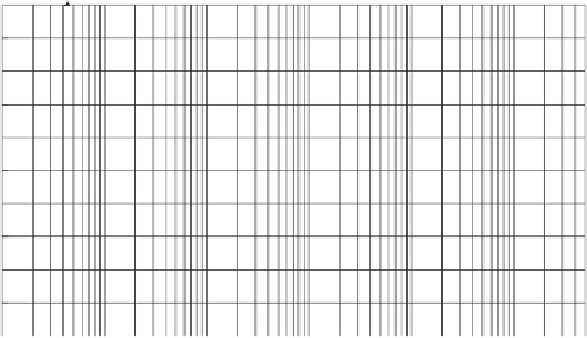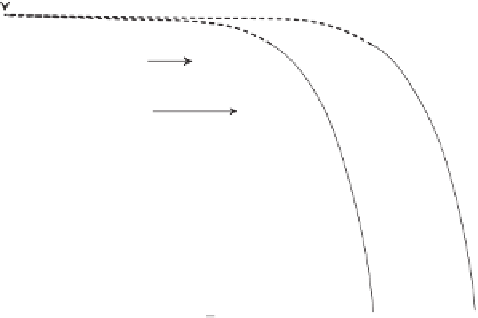Environmental Engineering Reference
In-Depth Information
Compressibility of water,
C
w
4.58 x 10
−
7
(kPa
−
1
)
=
0
100
Compressibility neglecting
solubility of air
Compressibility including
the solubility of air in
water
5
95
10
90
Volumetric coefficient
of solubility,
h
=
0.02
B
a
=
0.8
B
w
=
0.9
15
85
20
80
Initial absolute
air pressure, u
a
0
1013 kPa
101.3 kPa
10.13 kPa
25
75
10
−
7
10
−
6
10
−
5
10
−
4
10
−
3
10
−
2
Compressibility of air-water mixture (
C
aw
), kPa
−
1
Figure 15.9
Effect of solubility of air in water on compressibility of air-water mixture.
values must be set to 1.0. The resulting equation has the
following form:
(
1
−
S
+
hS
) u
a
0
C
aw
=
(15.17)
u
a
−
S
+
1
hS
Koning (1963) suggested another equation for the com-
pressibility of air-water mixtures. The equation was first
derived by expressing the pore-air and pore-water pressure
changes as a function of surface tension. However, changes
in the pore-air and pore-water pressures were later assumed
to be equal. This implies that the pore pressure parameters
B
a
and
B
w
are equal to 1.0. The compressibility associ-
ated with the solution of air in water was disregarded in the
derivation (i.e.,
hSB
a
/ u
a
=
C
aw
=
(15.14)
u
a
Equation 15.14 is slightly different from the equation pro-
posed by Bishop and Eldin (1950). The difference lies in the
definition of air compressibility. Equation 15.14 is derived
using the definition of air compressibility given in Eq. 15.2
[i.e.,
C
a
=−
(
1
/V
a
)/(
dV
a
/
du
a
)
]. The equation proposed
by Bishop and Eldin (1950) was derived with the air
compressibility defined with reference to the initial volume
of air,
V
a
0
:
0). Applying the above assump-
tions to the compressibility of an air-water mixture gives the
following equation (Koning, 1963):
1
V
a
0
dV
a
du
a
1
−
S
u
a
C
a
=−
(15.15)
C
aw
=
SC
w
+
(15.18)
Substituting the term
dV
a
/
du
a
from Eq. 15.4 into Eq. 15.15
yields a slightly different equation for compressibility:
Equation 15.18 was also suggested by Verruijt (1969) in
formulating the elastic storage of aquifers. The solubility of
air in water and the effect of matric suction were neglected.
u
a
0
u
a
C
a
=
(15.16)
15.3.6 Limitation Associated with Using Capillary
Equation When Formulating Air-Water
Compressibility Equation
The capillary equation (i.e.,
u
a
−
u
w
=
1
/ u
a
) describes the air com-
pressibility at a point on the volume-pressure curve during
undrained compression (see Fig. 15.5). Equation 15.16 gives
the average air compressibility during an air pressure change
from
Equation 15.6 (i.e.,
C
a
=
2
T
s
/R
s
)
relates
matric suction
u
a
−
u
w
to surface tension
T
s
through the
radius of curvature
R
s
of the air-water interface. Attempts
have also been made to use the capillary equation when
formulating an equation for the compressibility of air-water
mixtures (Schuurman, 1966; Barends, 1979). Equations
were proposed for the case of occluded air bubbles in soils
with a degree of saturation greater than approximately 85%.
The incorporation of the capillary equation results in the
u
a
(Skempton and Bishop, 1954). The difference
in the computed air compressibility from the two equations
is negligible when the air pressure change is infinitesimal.
Replacing the air compressibility term in Eq. 15.14 (i.e.,
1
/ u
a
) with the average air compressibility (i.e.,
u
a
0
to
u
a
0
/ u
a
)
yields the air-water mixture compressibility equation pro-
posed by Bishop and Eldin (1950):

























































Search WWH ::

Custom Search